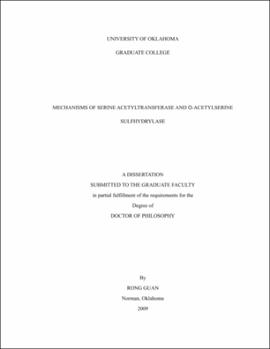| dc.description.abstract | The de novo biosynthesis of L-cysteine in enteric bacteria and higher plants is a two-step pathway. The first step is catalyzed by serine acetyltransferase (SAT), which converts acetyl CoA and L-serine to O-acetyl-L-serine and CoA via a sequential kinetic mechanism. A crystal structure of SAT with cysteine bound in the serine subsite of the active site shows that both H154 and H189 are within hydrogen-bonding distance to the cysteine thiol (Olsen, L. R., Huang, B., Vetting, M. W., and Roderick, S. L. (2004) Biochemistry 43, 6013-6019.). In addition, H154 is in an apparent dyad linkage with D139. The structure suggests that H154 is the most likely catalytic general base, and that H189 and D139 may also play important roles during the catalytic reaction. Site-directed mutagenesis was performed to mutate each of these three residues to Asn, one at a time. The V1/Et value of all of the single mutant enzymes decreased, with the largest decrease (~1240-fold) exhibited by the H154N mutant enzyme. Mutation of both histidines, H154N/H189N, gave a V1/Et ~23700-fold lower than that of the wild type enzyme. An increase in Kser was observed for the H189N, D139N and H154N/H189N mutant enzymes, while the H154N mutant enzyme gave an 8-fold decrease in Kser. For all three single mutant enzymes, V1/Et and V1/KserEt decrease at low pH and give a pKa of about 7, while the V1/Et of the double mutant enzyme was pH independent. The solvent deuterium kinetic isotope effects on V1 and V1/Kser decreased compared to wild type for the H154N mutant enzyme, and increased for the H189N mutant enzyme, but was about the same as that of wild type for D139N and H154N/H189N. Data suggest that H154, H189, and D139 play different catalytic roles for SAT. H154 likely serves as a general base, accepting a proton from the β-hydroxyl of serine as the tetrahedral intermediate is formed upon nucleophilic attack on the thioester carbonyl of acetyl CoA. However, activity is not completely lost upon elimination of H154 and thus, H189 may be able to serve as a back-up general base at a lower efficiency compared to H154; it also aids in binding and orienting the serine substrate. Aspartate 139, in dyad linkage with H154, likely facilitates catalysis, by increasing the basicity of H154. | |
| dc.description.abstract | O-acetylserine sulfhydrylase (OASS) is a pyridoxal 5′-phosphate (PLP)-dependent enzyme that catalyzes the second and last step of the biosynthesis of L-cysteine, the conversion of O-acetylserine and bisulfide to L-cysteine and acetate via a ping-pong kinetic mechanism. Enteric bacteria have two isozymes of O-acetylserine sulfhydrylase, A and B, which have different substrate specificity. The A- and B-isozymes are found under aerobic and anaerobic growth conditions, respectively. The 31P chemical shift of PLP is very sensitive to change in environment as intermediates along the reaction pathway are formed. The 31P chemical shift of the internal and external Schiff bases of PLP in OASS-B are further downfield compared to those of OASS-A, suggesting a tighter binding of the cofactor in the B-isozyme. The chemical shift of the internal Schiff base (ISB) of OASS-B is 6.2 ppm, which is the highest chemical shift reported for the internal Schiff base of a PLP-dependent enzyme. In the A-isozyme, for comparison, the chemical shift is 5.2 ppm, previously the highest reported (Cook, P. F., Hara, S., Nalabolu, S., and Schnackerz, K. D. (1992) Biochemistry 31, 2298-2303.). Considering the similarity in the binding sites of the PLP cofactor for both isozymes, torsional strain of the C5-C5′ bond (O4′-C5′-C5-C4) of the Schiff base is proposed to contribute to the further downfield shift. The chemical shift of lanthionine external Schiff base (ESB) of OASS-B is 6.0 ppm, upfield from 6.2 ppm of unliganded OASS-B, while that of serine ESB is 6.3 ppm, which is further downfield. The movements of chemical shift may suggest that torsional strain of PLP is changing as the formation of the ESBs. The line width of ISB is very similar to those of ESBs for OASS-B, indicating that there are no multiple conformers in ESBs of B-isozyme, consistent with the results obtained from UV-visible spectra studies (Chattopadhyay, A., Meier, M., Ivaninskii, S., Burkhard, P., Speroni, F., Campanini, B., Bettati, S., Mozzarelli, A., Rabeh, W. M., Li, L., and Cook, P. F. (2007) Biochemistry 46, 8315-8330.). | |
